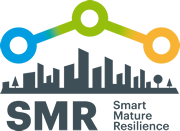Tools
RESILIENCE MATURITY MODEL
The Resilience Maturity Model provides a common understanding of the resilience building process. Using the Resilience Maturity Model, CITIES are asked to consider CITY’s current status of resilience. The model then helps to identify the correct policies to implement in order for the CITY to evolve and move to the next maturity stage.
The Resilience Maturity Model:
- can be used as part of strategic planning
- helps cities identify their level of resilience maturity
- helps cities to identify suitable policies to implement to develop resilience
- provides a point of reference for self-assessing effectiveness of resilience development
- helps cities prioritise resilience policy implementation on the basis of diagnosis and assessment
- can provide cities with justification for need for funding for specific measures
USING THE MATURITY MODEL
1. Find policies by maturity stage
The Resilience Maturity Model lays out a five-stage path for cities towards resilience maturity:
- Starting
- Moderate
- Advanced
- Robust and
- Vertebrate.
To find policies associated with one of the five maturity stages, click on the icon.
2. Find policies by dimension
The policies that cities can use to build resilience have been grouped into four main categories:
- Leadership & Governance
- Infrastructure and resources
- Preparedness
- Cooperation
To find policies associated with one of the four dimensions, click on the icon.
![]() Local government
Local government
![]()
Emergency services
![]() Critical infrastructures
Critical infrastructures
![]() Public-private companies
Public-private companies
![]() NGOs
NGOs
![]()
Volunteers
![]() Regional government
Regional government
![]() Media
Media
![]() Citizens
Citizens
![]() Academic and scientific entities
Academic and scientific entities
![]() National government
National government
![]()
European policymakers
![]() International organisations
International organisations
3. Find policies by stakeholder
Are you working in a city and would like to find policies applicable to your work? The icons left show the stakeholders involved in various stages on the resilience development process. Below, the stakeholders are listed according to stage at which they join the resilience development process. Once a stakeholder is involved, they continue to contribute from that point onwards. The final 'Vertebrate' stage involves all CITY stakeholders.
Starting
Local government
Emergency services
Critical infrastructures
Moderate
Public-private companies
NGOs
Volunteers
Regional government
Advanced
Media
Citizens
Academic and scientific entities
National government
Robust
European policymakers
VerTebrate
International organisations
![]() Municipality, cross-sectorial and multi-governance collaboration (L1)
Municipality, cross-sectorial and multi-governance collaboration (L1)
![]() Legislation development and refinement (L2)
Legislation development and refinement (L2)
![]() Learning culture (learning and dissemination) (L3)
Learning culture (learning and dissemination) (L3)
![]() Resilience action plan development (L4)
Resilience action plan development (L4)
![]() Reliability of CIs and their interdependences (I1)
Reliability of CIs and their interdependences (I1)
![]() Resources to build up resilience and to response (I2)
Resources to build up resilience and to response (I2)
![]() Development of partnerships with city stakeholders (C1)
Development of partnerships with city stakeholders (C1)
4. Find policies by subdimension
Ten policies subdimensions can be categorised under the four dimensions:
L: Leadership & Governance
L1: Municipality, cross-sectorial and multi-governance collaboration
L2: Legislation development and refinement
L3: Learning culture (learning and dissemination)
L4: Resilience action plan development
P: Preparedness
P1: Diagnosis and Assessment
P2: Education and Training
I: Infrastructure and resources
I1: Reliability of Cis and their interdependences
I2: Resources to build up resilience and to response
C: Cooperation
C1: Development of partnerships with city stakeholders
C2: Involvement in resilience networks of cities
To find policies associated with one of the ten subdimensions, click on the icon.
Subscribe to our newsletter

This project has received funding from the European Union’s Horizon 2020 research and innovation programme under grant agreement no. 653569.

